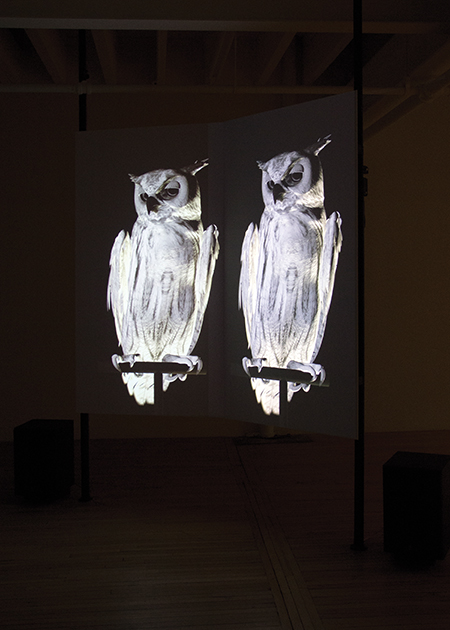Ann Lislegaard
Murray Guy, New York, USA
Murray Guy, New York, USA

Two identical owls perform the role of oracles in a video work that formed one element of Ann Lislegaard’s three-part installation ‘Oracles, Owls … Some Animals Never Sleep’ at Murray Guy. Seen in a black non-space, Lislegaard’s digitally animated birds – commanding, silvery white and lit from the left by an unearthly golden light – evoke the disquieting intelligence that we read into this species, with their large, rarely blinking eyes and measured movements. From twin beaks falls a stuttering mélange of voices and noises, delivered as though the owls were simply receivers picking up messages from elsewhere, or news from nowhere. (To be an oracle is to have one foot outside the present plane of existence, to have eyes that burn and a mouth that speaks words that don’t quite belong to it.) Some of these utterances are shards of dialogue from Ridley Scott’s Blade Runner (1982), the memorable film adaptation of Philip K. Dick’s Do Androids Dream of Electric Sheep? (1968), one of three science-fiction texts referenced in this exhibition.
‘Gender on other planets’, one owl says, cryptically. Or, as its eyes turn wide and fill with apocalyptic flames: ‘If only you could see what I’ve seen ... ’ Sometimes, all we hear is a digital, cacophonic white noise. Owls were, in Dick’s novel, the first species to die of the pollutants that pushed humans off the Earth. What’s powerful about Lislegaard’s Oracles, Owls … (2012–13) is that it stages an encounter with artificial intelligence in a way that both convincingly suggests that this might possess knowledge which can’t yet be fathomed by humans, while also provoking an uncontrollable empathetic reaction to animal life, confirming that both responses require attention in the present age.
The show’s other video installation, Dobaded (2014), also an animation, shows a monochrome view of an interior space. We tour tangles of wires, a bookcase, a plant collapsing inward into a view of a carousel of objects casting shadows, perhaps with a nod to László Moholy-Nagy’s Lichtrequisit einer Elektrischen Bühne (Light Prop for an Electric Stage, 1930). Whilst Moholy-Nagy’s work highlights film as a machine for casting light and shade, the focus on shadow play here is unsettling, emphasizing the absence of light in a digital space: these animated objects, of course, have no need to cast any shadow, other than to convince us of their realism. The titular word, dobaded, which appears streaming from a projector in the video, is taken from a poem that features in Kawamata Chiaki’s intriguing novel Genshigari (Death Sentences, 2012; anyone who reads the poem appears fated to die), though this oblique material and rather tenuous connection to Lislegaard’s video perhaps makes for a thinner experience.
Finally, a sugar-white geometric flower rests on a plinth – a 3D print in white nylon that appears to be part crystal, part iMac cable, part star-like rose. Titled The Flower from Weena, after evidence of the future brought home by the narrator in H.G. Wells’s The Time Machine (1895), it’s yet another example of an oracular presence, or a moment in which time is tripped up and the future sits with us, not altogether unpleasantly. We may tend to feel spooked, awed or mistrustful of the futuristic qualities of technological development, but one of the great insights of Dick’s fiction is that humanity’s frailties and strengths would remain relatively unaltered, no matter how transformed society would be by technology or disaster. Lately, I’ve become fond of turning over a line by Carlo Levi in my mind: in 1956 the Italian artist and writer wrote that ‘the future has an ancient heart’. Another way of saying this is that the seed for Lislegaard’s pristine, geometric flower – evidence of a technological age in which data can miraculously manifest as an object – was planted long ago, perhaps at the very beginning. Though it’s we who have tended it.

























